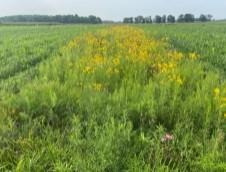“We found that a large swath of corn and soy cropland that is managed, could be converted to prairie strips under the appropriate payment schemes” said Luther who worked with Swinton and Van Deynze to analyze the 2018 survey experimental data. “This is an exciting result in an era where planting prairie strips is a new practice that is gaining increased attention by researchers and farmers alike.”
The study, funded by the National Science Foundation, was conducted in 2018 when prairie strips were added into MSU’sKellogg Biological Station Long-Term Ecological Research (KBS LTER) as part of a cross-disciplinary project to understand the ecological benefits of prairie strips in Michigan farming systems and farmer adoption.
In order to understand the willingness of farmers to adopt prairie strips, Braeden Van Deynze worked with Swinton and sociologist Sandra Marquart-Pyatt to design and implement the survey. It was released in 20 different versions, each one offering the recipient farmer a different payment for planting prairie strips on their largest field.
Not only were on-farm environmental benefits considered, but farmers’ perceptions on the local impacts of prairie strips mattered in their decision to adopt the practice.
“From prior survey research, we knew that row-crop farmers were likely to be reticent about adopting prairie strips without compensation,” said Swinton.
 A prairie strip planted within agricultural research fields at the W.K. Kellogg Biological Station Long-Term Ecological Research site. Photo by Elizabeth Schultheis.
A prairie strip planted within agricultural research fields at the W.K. Kellogg Biological Station Long-Term Ecological Research site. Photo by Elizabeth Schultheis.
In 2019, after the survey was completed, the United States Department of Agriculture (USDA) Farm Services Agency (FSA) introduced the Prairie Strip Conservation Practice (CP-43) into the 2018 Farm Bill. “That says that planting prairie strips could really scale up under a federal conservation program that already exists.” said Swinton.
This research serves as a link between ongoing research on the ecological benefits of planting prairie strips and the real-world farmers who decide whether to plant them. “These findings come at an opportune time, just as the KBS LTER is beginning research on the ecological and agronomic impacts of prairie strips through the new MiSTRIPS program, in collaboration with Iowa State. Our survey established a baseline willingness-to-adopt for regional farmers, setting up opportunities to track how KBS LTER findings might impact farmer adoption of this emerging practice in the future,” said Van Deynze.
Source : msu.edu